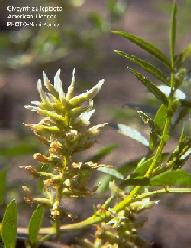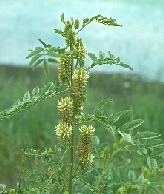

American Licorice
Glycyrrhiza Lepidota Nutt.
An aromatic, perennial herb, 1-3 feet tall, with deep creeping stems from deep rootstocks.. It has greenish-white flowers which are about 1/2 inches long. The flower stalks have axils of leaves with consist of 11 to 19 lance-shaped leaflets that are about 1 inch long. It flowers from June through the first part of August. Grows in moist, well drained soils, usually near water to include cultivated ground, waste places, roadsides, prairies, gravelly river bottoms and moist mountain draws. Usually grows in patches, frequently in heavy clay and saline soils. Reported by Nuttall on the banks of Lewis's (Snake) River. Found throughout Idaho.
Uses
Food: The root can be used raw or cooked. Long, sweet and fleshy, when
slow roasted was said to taste like sweet potatoes. They can be used as a flavoring
in other foods and can also be chewed raw as a masticator, making an excellent
tooth cleaner and also very good for teething children. It has been used in
confections, root beer, and chewing tobacco. The root contains 6% glycyrrhizin,
a substance that is 50 times sweeter than sugar. It has been used to flavor
candy and root beer. The tender young shoots can be eaten raw in the spring.
Medicine: American licorice was widely employed medicinally by a number of
native North American Indian tribes who used it in the treatment of a range of
diseases. All parts of the body are medicinal, but the roots are the most active
part. This species has properties similar to other liquorices which are widely
used medicinally, though this species is rather neglected in modern literature.
An infusion of the root is used to speed the delivery of the placenta after
childbirth, it is also used to treat coughs, diarrhea, chest pains, fevers in
children, Stomach ulcers, stomach aches, Arthritis, and rheumatism. It is also used as a wash or poultice on swellings.
The chewed root is retained in the mouth as a treatment for toothache and sore
throats. The mashed leaves are used as a poultice on sores. The leaves have been
placed in the shoes to absorb moisture..
Value to Animals:
Wild licorice is eaten by deer and pronghorn. Seeds are eaten by birds
and rodents. In Utah and Wyoming, wild licorice is eaten by deer, elk,
pronghorn, upland game birds, passerine birds, waterfowl, and small mammals.
Planting:
Requires a deep well cultivated fertile moisture-retentive soil for good
root production. Prefers a sandy soil with abundant moisture. Slightly alkaline
conditions produce the best plants. (PFAF)
